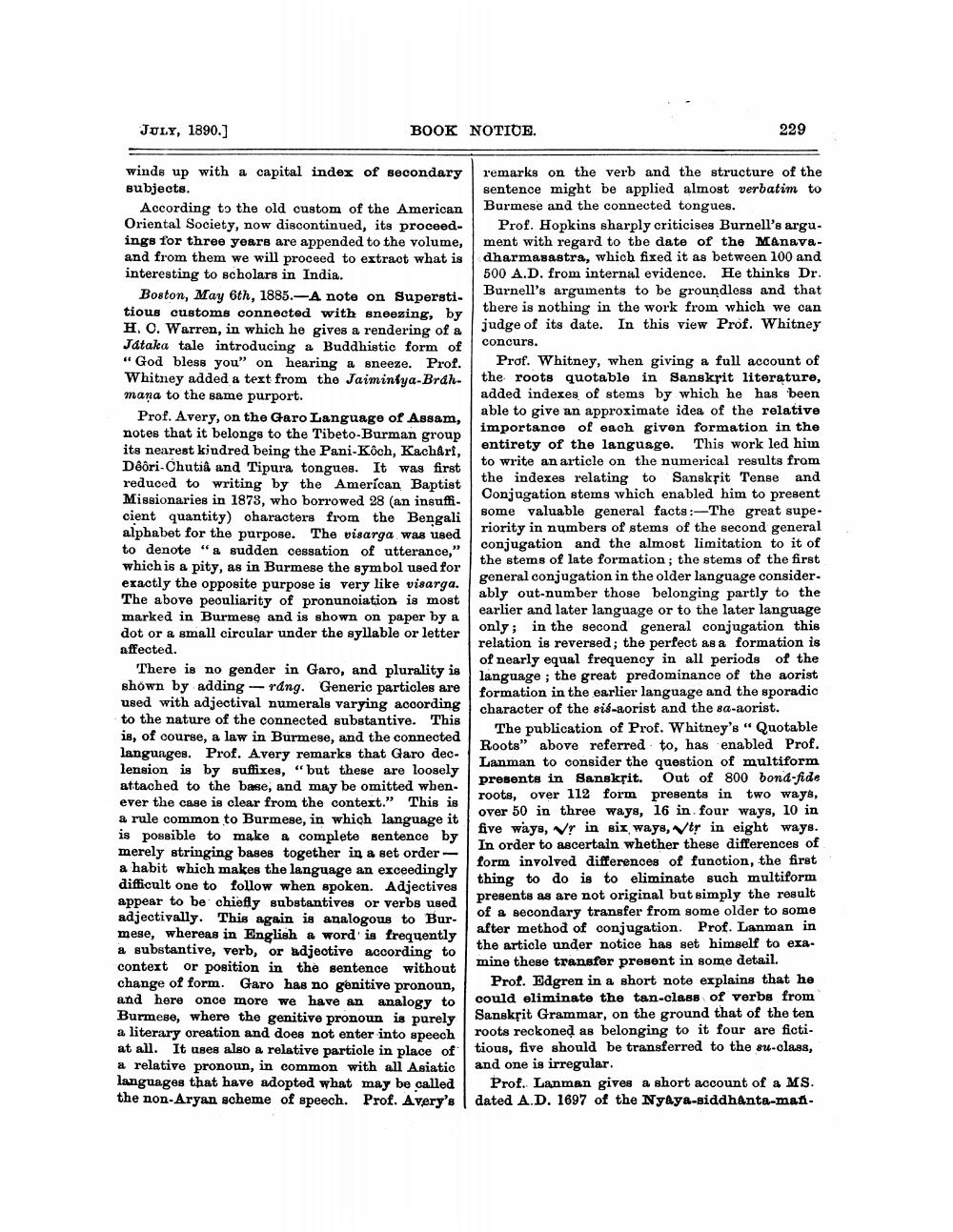________________
JULY, 1890.]
BOOK NOTICE.
winds up with a capital index of secondary remarks on the verb and the structure of the subjects. sentence might be applied almost verbatim to Burmese and the connected tongues.
According to the old custom of the American Oriental Society, now discontinued, its proceedings for three years are appended to the volume, and from them we will proceed to extract what is interesting to scholars in India.
Boston, May 6th, 1885.-A note on Superstitious customs connected with sneezing, by H. C. Warren, in which he gives a rendering of a Játaka tale introducing a Buddhistic form of "God bless you" on hearing a sneeze. Prof. Whitney added a text from the Jaiminiya-Brahmana to the same purport.
Prof. Avery, on the Garo Language of Assam, notes that it belongs to the Tibeto-Burman group its nearest kindred being the Pani-Kôch, Kachari, Dêôri-Chutia and Tipura tongues. It was first reduced to writing by the American Baptist Missionaries in 1873, who borrowed 28 (an insufficient quantity) characters from the Bengali alphabet for the purpose. The visarga was used to denote "a sudden cessation of utterance," which is a pity, as in Burmese the symbol used for exactly the opposite purpose is very like visarga. The above peculiarity of pronunciation is most marked in Burmese and is shown on paper by a dot or a small circular under the syllable or letter
affected.
229
There is no gender in Garo, and plurality is shown by adding - ráng. Generic particles are used with adjectival numerals varying according to the nature of the connected substantive. This is, of course, a law in Burmese, and the connected languages. Prof. Avery remarks that Garo declension is by suffixes, "but these are loosely attached to the base, and may be omitted whenever the case is clear from the context." This is a rule common to Burmese, in which language it is possible to make a complete sentence by merely stringing bases together in a set ordera habit which makes the language an exceedingly difficult one to follow when spoken. Adjectives appear to be chiefly substantives or verbs used adjectivally. This again is analogous to Burmese, whereas in English a word is frequently a substantive, verb, or adjective according to context or position in the sentence without change of form. Garo has no genitive pronoun, and here once more we have an analogy to Burmese, where the genitive pronoun is purely a literary creation and does not enter into speech at all. It uses also a relative particle in place of a relative pronoun, in common with all Asiatic languages that have adopted what may be called the non-Aryan scheme of speech. Prof. Avery's
Prof. Hopkins sharply criticises Burnell's argument with regard to the date of the Manavadharmasastra, which fixed it as between 100 and 500 A.D. from internal evidence. He thinks Dr. Burnell's arguments to be groundless and that
there is nothing in the work from which we can judge of its date. In this view Prof. Whitney
concurs.
Prof. Whitney, when giving a full account of the roots quotable in Sanskrit literature, added indexes of stems by which he has been able to give an approximate idea of the relative importance of each given formation in the entirety of the language. This work led him to write an article on the numerical results from the indexes relating to Sanskrit Tense and Conjugation stems which enabled him to present some valuable general facts:-The great superiority in numbers of stems of the second general conjugation and the almost limitation to it of the stems of late formation; the stems of the first general conjugation in the older language consider. ably out-number those belonging partly to the earlier and later language or to the later language only; in the second general conjugation this relation is reversed; the perfect as a formation is of nearly equal frequency in all periods of the
language; the great predominance of the aorist
formation in the earlier language and the sporadic character of the sis-aorist and the sa-aorist.
The publication of Prof. Whitney's "Quotable Roots" above referred to, has enabled Prof. Lanman to consider the question of multiform presents in Sanskrit. Out of 800 bond-fide roots, over 112 form presents in two ways, over 50 in three ways, 16 in four ways, 10 in five ways, in six ways, tr in eight ways. In order to ascertain whether these differences of form involved differences of function, the first thing to do is to eliminate such multiform presents as are not original but simply the result of a secondary transfer from some older to some after method of conjugation. Prof. Lanman in the article under notice has set himself to examine these transfer present in some detail.
Prof. Edgren in a short note explains that he could eliminate the tan-class of verbs from
Sanskrit Grammar, on the ground that of the ten roots reckoned as belonging to it four are fictitious, five should be transferred to the su-class, and one is irregular.
Prof. Lanman gives a short account of a MS. dated A.D. 1697 of the Nyaya-siddhanta-man




